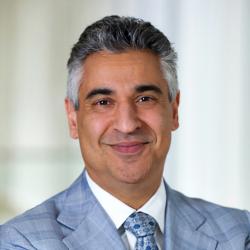Last year, the AAMC embarked on a new strategic plan in part to address some of the significant challenges and opportunities in our country’s health, from widespread health disparities to expanding access to care. We also created a think tank — the AAMC Research and Action Institute — that will tackle a number of these challenges and others facing the U.S. health care system.
I am a general internist with a health policy and economics background. Though I am an academic at heart, I have lived and worked for a long time inside the Beltway. What strikes me as missing from most of our conversations in health policy in Washington is the ability to balance academic rigor with political feasibility in plain, actionable English. That starts with defining — and sometimes explaining the complexity of — the problem, rather than immediately jumping to solutions or slogans.
Building on the Initial Work of the AAMC Research and Action Institute
The AAMC and the new AAMC Research and Action Institute spent a good portion of 2020 defining and explaining what we felt strongly were problems in the national response to COVID-19. Specifically, we sought to provide evidence-based guidelines to policymakers and the public about such issues as the wearing of face coverings and testing, at a time when the available science was limited, and it seemed like much of the nation’s response was politicized or questioned as the evidence evolved.
In July 2020, just as a second surge of the pandemic was threatening to overwhelm our hospitals, the AAMC issued a road map for a COVID-19 restart. The road map identified nine evidence-based actions essential to addressing the pandemic and two longer-term changes to improve overall health. Many of the items on that critical list are either well in progress or will be (finally) in the coming months. As millions of Americans are vaccinated every day, and as the Biden administration reaches its 100-day mark, I've spent a lot of time reflecting on our progress against that road map.
Breaking down the many challenges surfaced by COVID-19 has been critical to understanding individual problems and solutions. While shortages of equipment, drugs, and testing for COVID-19 continue to be challenges each in their own way, we have made progress. The critical supply shortages at the beginning of the pandemic — gloves, gowns, N95 masks, swabs, reagents, transport media, and, frankly, basic common sense — have all at least been recognized with efforts to address them.
Some of the items on the road map were never quite accomplished, such as establishing national criteria for in-person school and stay-at-home orders. There has at least been agreement on the reopening of K-12 schools as a national priority and the need to keep our health care workforce and patients safe.
Face coverings: Early in the pandemic, the nation lacked data and standards on wearing face coverings that were easy for people to understand. The Institute sought to simplify that guidance back in August as new data became available. The importance of masks as a way to reduce risk of infection is now clear, even if some choose not to wear them. Despite clear evidence for a public health intervention, like wearing face coverings, enacting change through policy is not easy. In this case, a lack of federal enforcement mechanisms makes national mandates nearly impossible except where under federal jurisdiction.
Testing: The nation’s infrastructure for COVID-19 testing proved woefully inadequate and dependent upon supply chains all over the world. But the public received bad or incomplete information about where the nation was and what was being done to address these shortages. As one physician policy leader recently shared on CNN, “When we said there were millions of tests available, there weren’t, right?”
Because of the challenges implementing an effective testing strategy, the Institute issued a set of recommendations for testing in October. These recommendations included a synthesis of excellent work from the Rockefeller Foundation, Harvard Global Health Institute, Brown University School of Public Health, Duke-Margolis Center for Health Policy, and others to clearly define a target of 9 million tests a day, given conditions on the ground and goals such as safely returning to school. The hope was to take academic work and translate it into unequivocal, clear, achievable recommendations.
Though this would have been achievable in six months, it's only recently that the current administration renewed the country’s investment in testing. This will be critical because, even though we have been able to test about 2.5 million people a day, we are still falling short of what is needed. It’s important to remember that even when a majority of people are vaccinated, we will need to continue to test regularly to identify and contain changing threats posed by this virus. A dashboard that provides clear and transparent information on the availability of tests continues to be needed as more people return to work and school and new variants continue to arise.
Vaccine distribution: Vaccine distribution could have been better planned and executed, and, as we called for in July, would likely have benefited from early prioritization and standardization of distribution protocols. Thankfully, the rapidly increasing availability of vaccines may overtake initial distribution inequities. Yet it is unclear how many Americans will want to be vaccinated as local infection rates decrease.
Data collection efforts should be patient-centered and accurately capture race and ethnicity data as well as information on the social and environmental conditions in which people live, work, and play (e.g., crowding, access to food, housing security) that affect how illness can spread.
Seeking Answers to Important Questions
We still face challenges in dealing with COVID-19. Transparency has improved, but we still struggle to have complete information about how the COVID-19 pandemic is being addressed. The political pressure to declare victory is always one that is hard to overcome. Recent, frequent updates from federal leadership have been transparent and candid even when our national goals are still elusive. What remains after this immediate crisis, then, as we laid out in the road map, is the work that has always eluded us:
- How do we permanently expand health insurance? Coverage was expanded through COBRA and additional subsidies under the Affordable Care Act but only for a couple of years.
- How do we expand coverage and access, reduce costs, and ensure equity in a system that remains a patchwork of local, state, and national programs?
- How do we truly advance the nation's public health infrastructure to better plan for and respond to future pandemics?
These questions bring me back to our new institute and why it was established.
Despite our long efforts as a nation, we are faced with the same intractable problems after the pandemic that we had before it. My hope is that we can bring some academically sound, rigorous thinking to these issues and deliver clear, articulate, actionable goals. As one noted health policy leader advised us early in this journey, I hope the work sometimes leads people to say, “Wow. I did not expect them to say that.”
It’s true — health policy is hard. But it is a little easier when we can clearly define the problems we are trying to solve and agree on at least some of the feasible goals for a healthier nation. This is only possible when those of us on the inside of health and public policy are willing to publicly acknowledge the interdependencies, flaws, and politically challenging trade-offs we must confront to make progress toward a healthier future. I hope you’ll be willing to engage with us on this journey to continue to move the ball further, faster. There is still so much work to be done, together.
Atul Grover, MD, PhD, is executive director of the AAMC Research and Action Institute. Subscribe to receive future communications from the Institute.

